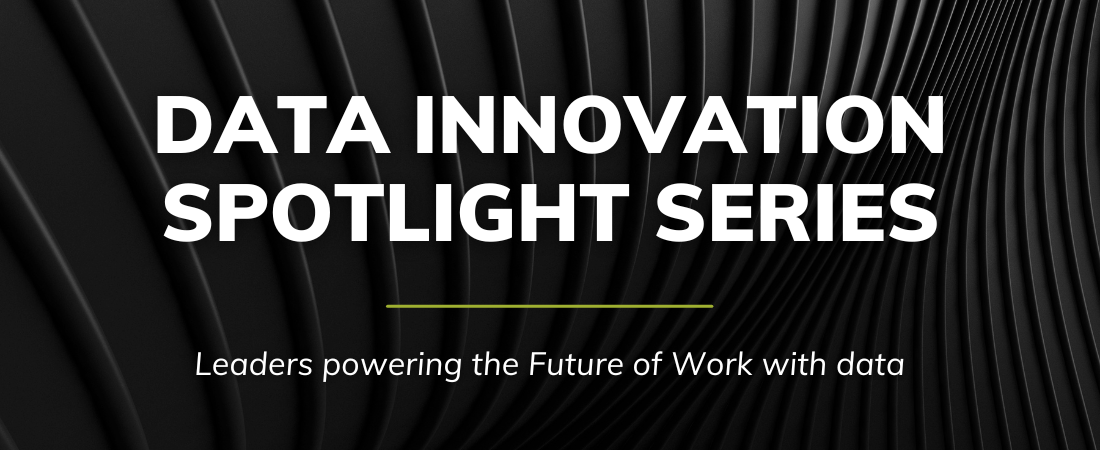**A recurring series to spotlight the leaders who are shaping the Future of Work through the lens of data. Today’s profile features Heather O’Hara Levesque, CIO of CAMP Systems and a catalyst of positive technical innovations.
Heather, welcome to the Data Innovation Series! Your background is incredible. Your work has ranged from supporting startups to Fortune 500 enterprises, and you’ve led everything from technology to product management to business development. To begin, can you share how you first got into technology?

Heather O’Hara Levesque: So I actually started down the path of becoming a psychologist, completing my Bachelor of Arts degree in Psychology & Statistics while running a Suicide and Crisis Help Line for the Canadian Mental Health Association in my local area. When not taking calls or training team members, I was working on a Windows 95 personal computer performing statistical analysis with a command line interface software called SPSS PC+. I used this to analyze research study data for my thesis and loved how it informed and guided the research process. I realized that I wanted to dive deeper into tech so I decided to make the jump and enroll in a post-graduate program in information technology to explore web development and data management.
Looking back, I could never have imagined that the revolutionary “at the time” SPSS PC+ software for regression, comparative analysis and reporting I used would years later become broader, easier and more efficient in the area of data science. The importance of data and utilizing it to inform decision making and innovation have always been a driving force in my career.
Talk about combining art and science in your leadership! How have you seen your psychology background continue to show up in your work today?
HL: What immediately comes to mind is just how important it is as a leader to help humans navigate change. Whether it was in my past working with somebody who was calling into the Suicide and Crisis Help Line or through my work today in examining the role collective psychology plays within an organization, I’ve found that it’s always imperative to get to the core of an individual or organization’s thought processes and mindset to determine how to successfully drive change. That’s especially important when you’re considering how to bring in technology that can change the fabric of an organization and someone’s role.
One of my earliest memories in dealing with the psychology behind technology change was when I was working at a company in which we had to move from a mainframe to Oracle. This was around the 2010-2012 timeframe. We were a completely mainframe shop — OS/390 IBM — and everybody was used to mainframes and didn’t want to move to relational databases or the web. We really had to dig into the fears, barriers, and obstacles, and meet people where they were to keep pushing for change.
Something a coworker said to me then, that has stayed with me, is that I will keep banging my head against the wall until I break through it!
I’ve carried that mentality with me throughout my career. You have to invest in people, bring them along, and show them the change that is possible. Especially given the pace of technology advancement today… the quantum leaps aren’t just happening every few years; they’re happening every year. And that requires taking a whole new approach with people because even though they are used to change, the change is overwhelming and they often don’t know where to start, what to learn, and where to dive into.
This is a perfect segue as I’d love to learn more about your role today as CIO at CAMP Systems, the leading independent provider of aviation management products and services with a proven track record of over 50 years.
HL: CAMP Systems has been around for a very long time, continues to expand geographically, and has also grown powerfully by acquisition. I came to CAMP Systems through Inventory Locator Service, which was one of the company’s acquisitions in 2019.
My current portfolio at CAMP Systems surrounds Security, Shared Services and Infrastructure. These are all fast-moving, service-oriented teams, vital to our internal and external customers. CAMP Systems and our wide range of products and services enable our industry to be productive, efficient and safe. I am most passionate about continuing to lead the organization’s journey in integrating and supporting digital technology and innovations in all areas of the business and continue to deliver value to our aviation customers. It is in my core to continue to establish a culture that relies on data and analytics for informed decision-making. Everyone should be empowered and feel confident in their data literacy and the major benefits that come with that.
At the highest level, I’m focused on establishing a holistic approach, seeing how we can grow together, and breaking down silos across those three areas. There’s a lot of communication that has to happen, a lot of relationship building, and a focus on building trust. I am lucky to work with amazing people who all share in the common mission of becoming better, improving, and growing, so it’s been really great so far!
Sounds like a great journey so far. As you’ve mentioned, establishing a culture that relies on data and analytics for informed decision-making is important to you. Through this series, we’re passionate about illuminating the many ways leaders (regardless of title and function) can win with data. When you think of some wins you’ve had with data, what comes to mind?
HL: There is no shortage of success stories when we leverage data internally and, in our products and services. Recently we put together a suite of insightful analytics to see more fully into our customers’ needs and behavior patterns — wanting to understand what makes users come in, what causes them to convert, what do they prioritize in our products, what’s happening behaviorally, and so on.
In aviation, the industry’s customer needs are unique. You have the small organizations holding maybe “two or three aircraft.” And then you have the giant OEMs, MROs and the major carriers. and they all have different needs. The data has helped us segment that and slice it and dice it so you don’t just have one approach to fit all. Instead, we can look at microsegments. Thanks to what we’ve done with our data and business intelligence strategy, it has allowed the sales and marketing teams to do that really easily and effectively.
One of the most powerful components of data and its elevation is that it leads to really great conversations where we can dive deeper and deeper. And that’s really fun when you can get past the surface-level questions, ask harder questions, and really dig into a problem or opportunity as a team.
Absolutely! When we shift from safe or easy data cultures (measuring what’s easy, customary, accessible) to leveraging data to be bold and brave, the real wins can emerge. If you look out a few months/year, what are you most excited about when it comes to the data and advanced analytics front?
HL: Over the years, I’ve experienced major shifts in the data field. The sheer explosion of data, the rise of data visualization tools and AI/ML mania. The volume, variety, and velocity of structured and unstructured data have increased exponentially since I have started my career. When I was a Database Administrator, we were stressing our systems to be able to handle the data influx and I never stopped asking for more space. There was never enough. Now our modern systems have critical de-dup functionality, distributed computing and cloud options making data management much easier.
Similarly, as a Business Intelligence Architect and Manager, I have seen reporting tools evolve. The shift from early reporting software to advanced analytics and visualization software was rewarding to help organizations adopt. I implemented everything from Crystal reports, Spotfire, Oracle Business Intelligence Suite Enterprise Edition (OBIEE), to Tableau, Power BI and beyond. All supporting a major leap forward in data analytics, visualization and useability.
The most exciting recent shift for me has been implementing AI and Machine Learning models, and now venturing into Generative AI. My team and I started developing skills and rolling out AI/ML products to customers back in 2018. The availability of open-source tools like R and Python has significantly democratized access to advanced analytics, far surpassing the old SPSS PC+ days! As generative AI evolves at a rapid pace, it’s fascinating to anticipate what innovations will emerge to support AGI. What data innovations will come to bear to support all forms of AI is an exciting prospect.
Diving a bit deeper into the theme of this series, and jumping off of your last statement, how do you define the term “data innovation?”
HL: Data innovation to me is about providing insights that you didn’t already have to help run the business.
I especially love when that data and insight can power the creation of a new customer product. I get a huge kick out of sitting with a customer, hearing them articulate their challenges or desires, and taking those requirements and data back to the tech team so they can start working. When you can finally release a product that your customers just gobble up and they love, that’s such a win.
In a different vein, data innovation wins can also be small and add up over time. For example, early in my career, I did a lot of Lean Six Sigma and Kaizen and that requires lots of data to help improve those processes. We had one process that was taking people 20 hours extra a week, and we completely eliminated it. People still talk about this success! It became part of cultural lore. That’s why you have to keep looking at your processes and pulling the data to see what’s next that you can innovate and streamline.
For sure! The next win is always there. OK, final question… what advice would you offer to anyone who is looking to get into tech leadership?
HL: What I always tell people who want to get into tech leadership is to not view management as a promotion. It’s a very different field. I like to think about it as two different tracks.
One is a tech track where you’re a system database administrator or a system admin, and you can progress really high up the chain on that. The other track is management, which is a parallel path where you’re using data, technology, and the power of people to make change and improvements in the organization.
To decide which track is right for you, ask, ‘What is my passion? Where do I want to go?’ Management is not for everybody and yet everybody thinks they have to be promoted into management to keep growing their tech career. But that’s not true. You can forge your own path. Find out what you love and then just work hard and take on new assignments. Keep learning new things. Be willing to always learn, unlearn and relearn and consider how you, your team, and your organization can collectively benefit from this learning.
**Know someone who is championing data innovation efforts? Interested in being profiled for our spotlight series? Click here to throw your hat in the ring, or to nominate a peer.**

